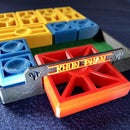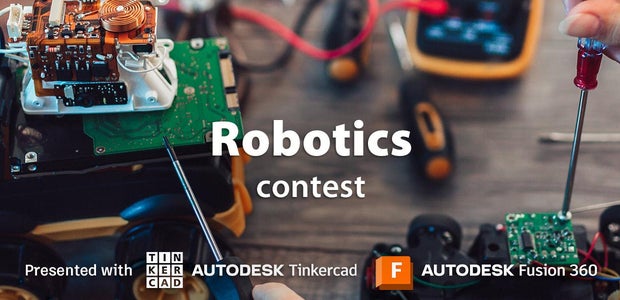Introduction: Spice Glasses Chandelier - USB - LED 5V - 3D Printed
„The last few years we have now and then bought garlic pepper in small glass jars in our supermarket. A product of an Europe-wide chain of steakhouses.
At first, these small glass jars ( approx. Ø 50mm x H 84 without lid) were just too bad for me to throw them away in the glass container. Therefore, they were kept.“ (Quote from my introduction to "Small Parts Organizer/Spice Rack". It is also valid for this project!)
So, as just mentioned, I have already built some time ago the "Small Parts Organizer/Spice Rack“ https://www.instructables.com/Small-Parts-Organizer-Spice-Rack/ from these jars. Well, there are still some jars left and new ones have been added.
Inspired by the contest on the theme „Repair and Reuse“, I have thought to reuse those jars and design this lamp.
The LED light color is warm white.
This lamp is not intended to illuminate a room but - due to its low luminosity - rather as a mood lamp.
Dimensions:
- base: Ø 180 mm
- width: 340 mm
- height: 290 mm
Supplies
For this project you need:
- LEDs 5V (5x)
- jars Ø 50 x 84 mm (5x)
- self tapping screws Ø 2 x 8 mm (20x)
- switching wire (0,22 mm²), different colors
- USB Type A plug with cable
- luster clamp
- soldering iron
- solder
- heat shrink tubing
- lighter
- 2 position mini toggle switch
- wrench 8 mm
- cable tie
- Phillips screwdriver
- screwdriver
- tweezers
- piercer
Here you can get some of the necessary parts:
- LED: https://www.amazon.de/dp/B07N235QDS?ref=ppx_yo2ov_dt_b_product_details&th=1
- Switch: https://www.amazon.de/gp/product/B01MXLZ7R1/ref=ppx_yo_dt_b_asin_title_o03_s00?ie=UTF8&psc=1
- USB charging adapter: https://www.amazon.de/USB-Netzteil-Ladeger%C3%A4t-Steckdosenadapter-Kompatibel-White/dp/B09NNXHPG7/ref=sr_1_5?crid=3LCD68LUWVXSM&keywords=usb+charging+adapter&qid=1679570235&s=ce-de&sprefix=USB+Charging+ad%2Celectronics%2C70&sr=1-5
Step 1: Printing
First you have to print the following files:
- base.stl
- octagon.stl
- lid.stl (5x)
- connector.stl (5x)
- reflector.stl (5x) (optional)
On the pictures you can see a smaller number of pieces on the printing plate. This is because I had already printed test single pieces.
Print settings:
- printer brand: Prusa, Flashforge
- printer: MK3S/MIni/Finder
- supports: No
- resolution: 0,2
- infill: base.stl 5%, all other parts 15%
- filament brand: Prusa; ICE
- filament color: Galaxy Black; Romantic Red, Wintershine White
- filament material: PLA
Remark: As all parts are designed to fit very precisely, it may happen that you have to rework one or the other part a bit with sandpaper and/or cutter due to different dimensional accuracy of the printers and the different behavior of the filaments.
Attachments
Step 2: Assemble LED Socket
After all parts have been printed and all product labels removed, you can now start to assemble the bracket and the lid.
For this you need:
- connector.stl (5x)
- lid.stl (5x)
- self tapping screws Ø 2 x 8 mm (20x)
- Phillips screwdriver
- piercer
It makes it easier to screw in the small screws if you carefully prick the holes in the "connector.stl".
Step 3: Electrics: Lengthen Wires
The wires on the LEDs have a length of about 20 cm. This is not enough for the wiring inside the chandelier. So they have to be extended - depending on the position.
You'll need:
- switching wire (0,22 mm², black and red) 1x 20 cm, 2x 15 cm, 2x 10 cm (for each color)
- wire stripper
- soldering iron
- solder
- soldering grease
- heat shrink tubing
- lighter
I recommend not to use thicker cables, because it gets a bit tight in the cable channel of the octagon. In addition, the solder connections must be kept as slim as possible. Also, do not use heat shrink tubing that is too wide!
The extension applies to all LED connections, but with different lengths due to their position on the lamp:
- upper LED = 20cm
- both 45% LEDs = 15cm
- both horizontal LEDs = 10cm
Step 4: Electrics: Wiring - Inserting Cables
For this operation you need:
- the 5 assembled LED sockets
- the 5 LEDs with the extended cables
- tweezers
- small screwdriver
This is probably the most complicated part of building this lamp. You need patience, skill and a good eye when pushing the cables through. The most difficult will be the side where at the end in the last section 4 existing cables must be passed.
It makes sense to test the LEDs before installation. It can happen that one of them does not work. It would be annoying to find out only after installation.
- Start with the top LED. Cable length 20cm. This process is still relatively easy, since no other cables are installed yet. I twisted the ends of the cables to make it easier to push them through. Lead the two cables first from above through the LED socket, then through the right or left side of the octagon. I chose the right one. There is a larger hole vertically below the top position. There the two cables must be led out.
- For the transport of the cables inside the cable channel, tweezers and screwdriver can be very helpful! This is especially useful when other cables are already installed. It can also be helpful to push the cables through individually rather than in pairs.
- Next, lead the 2nd LED over the left side. This step is also simple, since no other cable is laid here yet.
- Continue on the left side. The cables of the 3rd LED must now be led along the two already existing cables in the last part of the octagon.
- Back to the right side. Insert the 4th LED. There are already two cables here as well
- The 5th and last LED. Now it is getting tight. There are already 4 cables here. Here you have to help with a screwdriver and tweezers. The problem is that you don't always hit the right cable. Here you really need patience! I have managed it ...
Step 5: Glue Parts
All you need is:
- super glue
Now the time has come to glue the parts.
In my case, the LED sockets were already relatively tight on the octagon. Lift the LED sockets slightly and put a drop of superglue in the recess. Then press firmly for 10-20 seconds.
When all LED sockets are glued, lead the complete cable bundle through the hole in the lamp socket. Put a drop of superglue into the recess. Press the octagon firmly into place, making sure it is seated correctly.
Step 6: Electrics: Wiring - Preparing Power Connection
Now you need
- luster clamp
- switching wire (0,22 mm²), 10cm
- USB Type A plug with cable
- soldering iron
- solder
- heat shrink tubing or insulating tape
- lighter
- 2 position mini toggle switch
- wrench 8 mm
- cable tie
The LEDs are equipped with a series resistor for 5V. They are connected in parallel to the 5V source.
First start by sorting the cables. When you have all the black ones together, try to bring the cable ends together and put them into one of the two holes of the luster clump. Then do the same with the red cables and put them into the empty hole. After that you can wind the whole cable bundle around the center axis of the base.
Now take the USB cable - strip the cable ends first - and lead the cable through the hole on the back of the base.
Solder one end of the cable to one of the two pins of the switch.
Now take a 10 cm long piece of cable and connect the 2nd terminal of the switch to the still empty hole of the luster clamp.
Now you can test if all 5 LEDs are on. For this you need a 5V USB power supply.
To prevent the USB cable from being pulled out, take a cable tie and fix it to the cable inside the base.
The last thing to do is to attach the switch. Put it through the hole from the inside and fix it with the corresponding nut. For this you need a 8mm wrench.
Now you can start the lamp via USB power supply!
Step 7: Insert "reflector" (optional)
You'll need
- reflector.stl
I called it a "reflector" because of the white surface of the cone that, when viewed from the side, creates a bright glow that I like. It is not a reflector, of course, reflecting the light. However, it probably only works with white filament.
"Reflector.stl" is a flat cone with 4 tongues. These tongues are somewhat flexible with a thickness of 0.6mm and can thus be carefully pressed through the glass opening. In the bottom area of the glass is a narrow concave rim, in which the "reflector" snaps in.
Step 8: Colour Suggestions
If you're looking for color variations, here are some suggestions.

Participated in the
Repair and Reuse Contest



















Comments